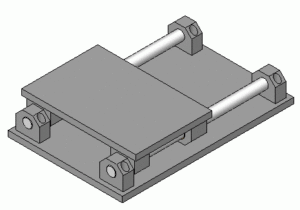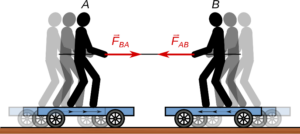The first person to formulate the fundamental laws of physics that govern the dynamics in classical non-relativistic physics is Sir Isaac Newton. Dynamic force is a major part of Linear dynamics. Some example of dynamics or dynamic force application are as follows:
Let us learn about example of dynamics in detail.
Example of Dynamics
Dynamic force refers to the type of force that enables an object to vary or change its shape, size, position, speed, or direction. Dynamic forces depend on time. Dynamic force is used in a number of days to day activities or phenomena such as:
1. Earthquake
The phenomenon of earthquake takes place when the Earth’s tectonic plates get displaced from their original position and collide with one another. This collision of tectonic plates leads to the formation of seismic waves. This movement of tectonic plates happens inside the core of the earth however the effect of this collision is also seen on the surface where the object such as houses, buildings, trees, poles, etc. start shaking. This movement on the surface of the Earth is caused by the seismic force which is a type of dynamic force.

2. Movement of cars
A car engine supplies a driving force that helps the vehicle accelerate and move forward. This driving force of the car engine is a form of dynamic force exerted on the car to help it change its position from one place to another with time. Dynamic forces are time-dependent i.e. the change in position occurs with respect to time.
3. Hitting a cricket ball
A bowler throws a cricket ball at a certain pace towards the batsman. The batsman hits the incoming ball by the bat and changes its position, direction, and speed. The force exerted by the batsman on the ball with the help of a bat is a dynamic force.
4. Hammering a metal
Metal is molded into different shapes and sizes by the heating and hitting procedure. Metals are ductile and malleable in nature. For transforming a raw piece of metal into a sheet or a wire a procedure is used that and was repeatedly hitting the surface of the metal with a certain force with the help of a rigid object. The force exerted helps to modify the shape of the metal and is hence a dynamic force.
5. Throwing an object.
We throw an object by using the muscular force in our body. After throwing the object changes its speed with respect to time. This muscular force exerted by our body is a form of dynamic force. This can be proved by the first law of motion by Newton that states that an object cannot change its speed without the application of external force.
6. Inflating a balloon
Balloons are made up of elastic rubber membranes. For inflating a balloon, we exert force on the elastic membrane by stuffing a balloon with air. The force exerted on the walls of the balloon changes its shape and size and is hence a dynamic force.
7. Churning milk
The process of churning milk involves the spinning of milk at high speed by using a blender, mixer, or even manually by using a spoon. After a certain amount of time, the spinning causes the cream to get separated from the milk and come up. The constant spinning motion causes the milk to change its state from liquid to semi-liquid. Hence, we can say that the force exerted for spinning the milk is a type of dynamic force.
Now, let us have a detailed look at the term “dynamics” for a better understanding.
The term Dynamics refers to a field in classical mechanics that deals with the study of forces and the effect of forces on motion. The two main types of dynamics are:
Linear dynamics:
The term linear dynamics hold true for objects that propagate or move in a straight line i.e. objects having a linear motion. Mathematically, linear dynamics is represented by linear algebraic equations.
The quantities that fall under linear dynamics are force (product of mass and acceleration), inertia or mass, velocity (i.e. displacement per unit time), displacement (in the same unit as distance), acceleration (displacement per unit time squared), and momentum (product of mass and velocity). For most linear dynamics calculations, the object taken is considered to be e a point size particle that has its mass concentrated at one point. In other words, we can say that all the forces act on the center of mass of that particular object.

Linear dynamics and linear motion is mainly governed by Sir Isaac Newton’s three laws of motion:
First law– An object at rest stays at rest unless an external force acts on it. An object in motion continues to be in motion having a constant velocity until and unless an external force acts on it.
In other words, we can say that an object that does not have an external force acting on it can either be at rest or in a motion with constant speed in one direction.
Second law- The acceleration of a moving object is directed in the direction of the net external force that acts on it.
Acceleration is said to be directly proportional to the net external force acting on an object and is inversely proportional to the mass of the object. Another way to define the second law is that an object’s rate of change of linear momentum is equivalent to the net external force acting on the object. Mathematically this can be represented as F = ma & dp/dt = Fnet.
Third law- Every action has an equal and opposite reaction.
This means that force acting on an object comes in the form of a pair that is equal and opposite in nature. We can say that if an object P is exerting force on another object Q then the object Q is also exerting an equal amount of force in the direction opposite to that of P. Mathematically 10 can be represented as Fp = – Fq.

**It should be noted that the three laws of motion by Isaac Newton are valid in an inertial reference frame only.
Nonlinear/Rotational dynamics:

The term nonlinear rotational dynamics holds true for objects that propagate or move in a rotating or curved path. Physical quantities that are described by rotational dynamics are torque (cross product of the force vector and the position vector), angular displacement (in degrees or radians), the moment of inertia or rotational inertia (product of the mass of an object and the square of the distance between the centroid of the object and the reference axis), angular acceleration (radians covered per unit time squared), angular velocity (radians covered per unit time), and angular momentum (product of moment of inertia and angular velocity).
Rotational dynamics can also be governed by the modified three laws of motion:
First law- An object at rest has a tendency to remain at rest and a rotating object has a tendency to continue rotating with a constant angular velocity until and unless the object experiences some net external torque.
Second law: The angular acceleration of an object is directly proportional to the net external torque. The moment of inertia of the object and its angular acceleration is inversely proportional. Mathematically, this is represented by the equation τ = Iα. We can also say that the rate of change of angular momentum gives the net external torque acting on the object.
Third law- Every action has an equal and opposite reaction. In this case, we are talking about the torque exerted on an object as the action.
What is the principle of dynamics?
Typically, researchers and scientists who study dynamics observe the changes occurring in the physical system over time and then analyze the cause of those alterations.
Dynamics is studied by observing and analyzing the system of mechanics developed by Sir Isaac Newton dynamics is governed by the fundamental physical laws developed by Newton. The second law of motion given by Newton is particularly very important in studying dynamics. However, because of the fact that all the three laws of motion are interrelated to some extent, we have to take all the three laws into consideration while observing the Dynamics of a system.
In the case of classical electromagnetism, the kinematics of a system is studied by Maxwell’s equations. In a classical system, dynamics involves a combination of both electromagnetism and mechanics that is described by Maxwell’s equations, Newton’s laws, and Lorentz force together.
What is Lorentz force?
Lorentz force guides a major portion of classisal electromagnetism studies.
The force that a charged particle q experiences while moving with the velocity v under the influence of magnetic field B and electric field E is called Lorentz force. Lorentz force is named after the Dutch physicist Hendrik A. Lorentz. The charged particle experiences an electromagnetic force F (i.e. the Lorentz force) that is given by the equation F = qE + qv × B.
What are Maxwell’s equations?
James Clerk Maxwell formulated a set of coupled partial differential equations by putting together the Lorentz force law, classical optics, electrical circuits, and the laws of the foundation of classical electromagnetism. These equations are now known as Maxwell’s equations of electromagnetics.
The four Maxwell’s equations that govern the field of electromagnetics are:
1. Gauss’ law for electric fields- It states that if we integrate the outgoing electric field E over an area, the result is equal to the total charge Q inside the volume divided by permeability of space.

2. Gauss’ law for a magnetic field- It states that the integral of magnetic field B over an enclosed area is equal to zero.

3. Faraday’s law of magnetic induction– It states that the integral of the electric field over a closed line such as a wire gives the change in total voltage around the circuit. This voltage is generated by the varying magnetic field throughout the circuit.

4. Ampere’s law with Maxwell’s displacement current– It provides the total magnetic force around a circuit in terms of the current through the circuit with any varying electric field caused by the displacement current.

We hope this post presented all the required information regarding the example of dynamics in physics.
Also Read:
